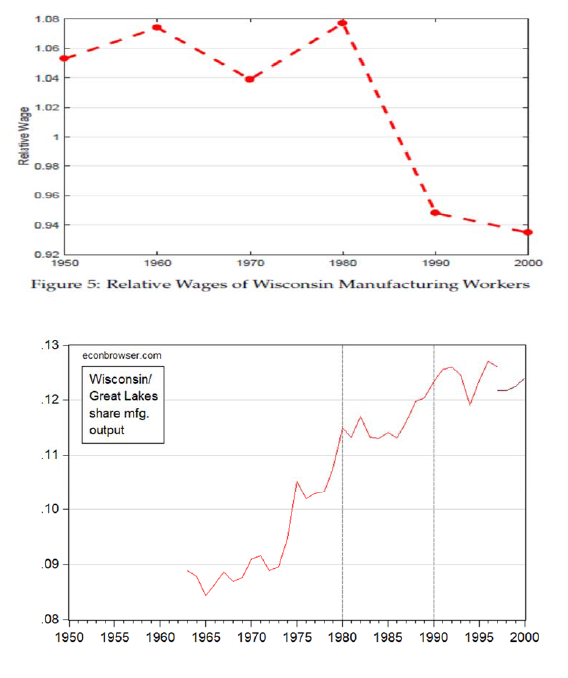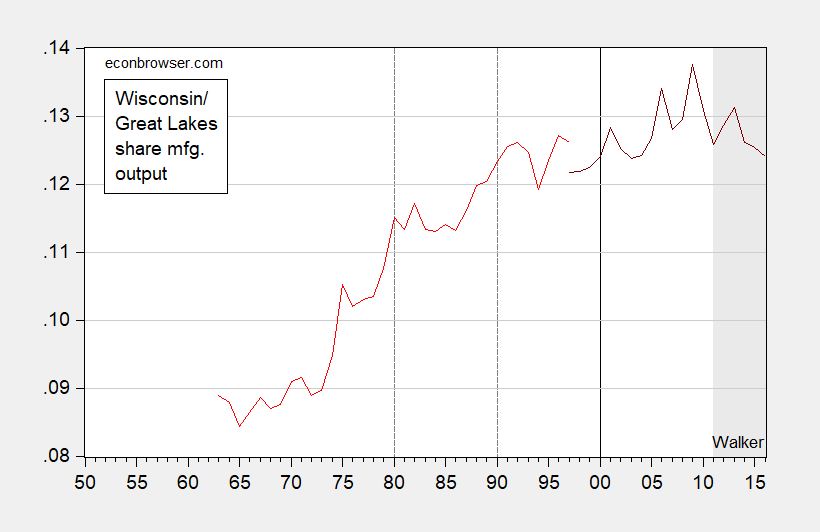As suggested here. Maybe. It might depend on the measure of economic activity.
One viewpoint is that high wages discouraged employment in Wisconsin. Below, I show the wage premium from Alder et al. (2017), and Wisconsin’s manufacturing value added as a share of the Great Lakes region, for the 1950-2000 period (1963 onward for GDP).

Figure 1: Top – Wisconsin wage premium from Alder et al. (2017) and Bottom – Wisconsin’s manufacturing value added share of Great Lakes. NAICS data 1997 onward. Source: Alder et al. (2017), BEA regional data, and author’s calculations.
To me, it seems like the expansion of Wisconsin’s share decelerates 1980-1990 as the Wisconsin wage premium declines, and at a minimum does not accelerate 1990-2000 (maybe even slows further!) when one would’ve thought it would accelerate with the decreased Wisconsin wage premium.
For completeness sake, I include the series extended up to 2016. Wisconsin’s share is essentially the same as it was in 2000 (and less than it was in 2010).

Figure 2: Wisconsin’s manufacturing value added share of Great Lakes. NAICS data 1997 onward. Gray shaded denotes Walker administrations. Source: Alder et al. (2017), BEA regional data, and author’s calculations.
For trends at a higher frequency, pertaining to real output, see this post.
Lee Ohanian was a co-author of that piece. Figures as he has argued that the Great Depression was not a Keynesian event. Oh no – FDR’s policies to address weak employment made the situation worse according to this crowd.
I wouldn’t be too smug about it. Hoover started Keynesian economics and the situation became worse:
“When it was all over, I once made a list of New Deal ventures begun during Hoover’s years as Secretary of Commerce and then as president. . . . The New Deal owed much to what he had begun.1 —FDR advisor Rexford G. Tugwell
Hoover did not stand idly by after the depression began. To fight the rapidly worsening depression, Hoover extended the size and scope of the federal government in six major areas: (1) federal spending, (2) agriculture, (3) wage policy, (4) immigration, (5) international trade, and (6) tax policy.
http://www.econlib.org/library/Enc/HooversEconomicPolicies.html
“Hoover did not stand idly by after the depression began. ” OK?! So Hoover eventually got it but not Peak Trader. Could you get more off point?
Krugman on Ohanian:
https://krugman.blogs.nytimes.com/2011/09/27/bad-faith-economic-history/
Just a few questions and observations:
– Is the relative wage information available from 2000 to present? With 16 or 17 years of data missing, it is difficult to draw conclusions about the present.
– Michigan’s manufacturing suffered in the early 70s and 80s from the “oil shocks”; did Wisconsin’s manufacturing also get impacted similarly?
– Automotive manufacturing in Michigan ramped up considerably after 2010; did that impact the share of manufacturing in Great Lakes states that were not as heavily invested in automotive manufacturing?
– Was the loss of Caterpillar and other manufacturing jobs a result of Walker’s policies or non-competitive wages or something else? Did those companies and jobs just disappear or were they moved elsewhere and why?